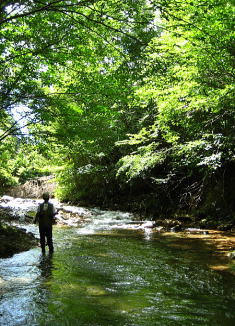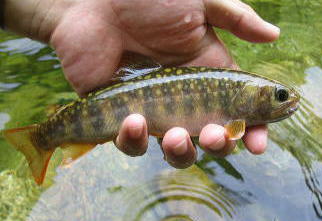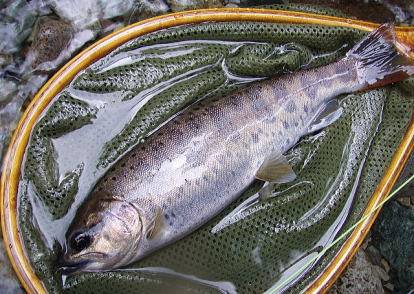Another inhabitant of Ohta river worth special remarks is ''Ohsansho Uo'',
or giant salamander. Growing to a meter in length, they are the largest,
and one of the most ancient amphibians alive on the planet. Preserving
the pristine environment for them is a duty and a privilege of us.
Broad-leaved trees hold water much better than coniferous ones. A 100 years
old adult beech can store up to 1 ton of water in its roots. They also
provide the wildlife with a means of subsistence while enriching the soil
in a macro perspective. We can only regret having traded such valuable
assets for transient commodities.
Trekking deeper into the valleys of Yoshiwa, we can still find age old
'dog beech' and other siblings. Although they grow nowhere near as grand
as 'Buna' beech, they often form interesting contours to entertain the
visitors.
Deep into the upper reach of sharp chiseled valley, in the cold, gin clear
waters we find 'Iwana', a Japanese char. These char in the western part
of Honshu carry characteristic white spots on their back.
Princess of stream is a courtesy title we dedicate to 'Amego', who greets
and flirts with us so charmingly that we have to go back begging for their
love day after day!
Interestingly, some genetic group of Amego trout descend down to the sea
like Salmon. They typically spend half a year in the sea, before coming
back as 'Satsukimasu', literally, 'May trout'. Their happies days have
gone, but with the conservation effort of recent decades, they are making
a modest come back.
The small streams join one another to form a river. And here on a bright
sunny afternoon, she begins her 100km long journey down to the sea.
- Ohta river - middle section
105kms in length, Ohta originates in the mountains of 'Yoshiwa', north
western corner of Hiroshima prefecture. The distance from the population
center, albeit modest, kept streams here in the margins of relentless development
- so far.
Green canopy of thick vegetation shelters the stream from the sky. Even
the omnipresent jingling of cicadas echo in distance. Deep in the bottom
of a valley, a mystic silence rules.
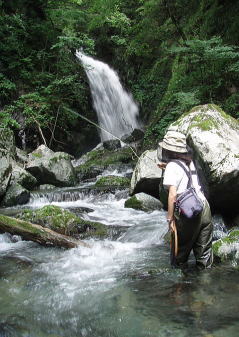
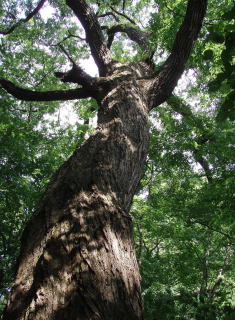
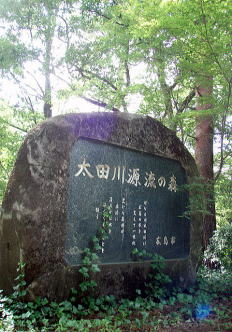
The official birth place of Ohta river is Kanmuriyama, the second tallest
mountain of Hiroshima at 1,339m above sea. You can visit the monument proclaiming
the nature reserve where re-forestation effort is starting to bear fruits.
In the post-war industrialization era, large portion of wild forest were
cut down to produce charcoal. In their places they planted furs and pines,
which grows faster and stands upright, therefore commercially more valuable.
It took us years to realize the reduced productivity of the sea was attributed
to the disappearance of Buna (beech) trees. Sobering to know the oyster
fishermen nowadays are the major activists planting trees up in the mountains.
None of us are irrelevant. We are part of it.
Once prosperous logging industry has all practically gone, those few people
venturing thus far are either seasoned locals harvesting Wasabi herbs,
or us the recreational visitors.
Even in a world that seems so detached, we occasionally come across to
the footsteps of our ancestors - a rotten log bridge, or a stone wall buried
in bush. Hands placed on those artifacts we close our eyes for a moment.
And then, we sometimes hear those gentle voices greeting us . . .
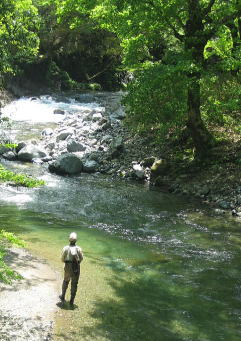

In Chugoku range west of Japan, there are no alpine peaks to nurture great
rivers. The coastline along the inland sea, Setonaikai as it's called,
is one of our nation's major population center. The city of Hiroshima alone
has over a million population, so the pressure we create on our lifeline
is significant.
But there are rising public awareness also, for the future of our rivers,
and that of our own. I for one would like to contribute to this worthy
movement. With that as a preface, allow me to introduce you the provider
of Hiroshima, Ohta river.
 Ohta - upper section
Ohta - upper section

